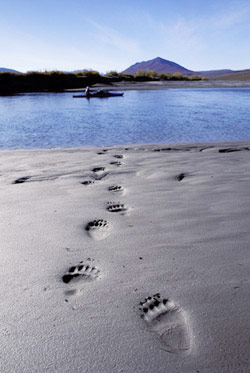"There
was no lack of color rising from living things -- but it
is only that the eye beholds too much in this land that
has no roof and no containing walls. The colors flow together
and are lost in distance that the eye cannot embrace.”
--Farlet
Mowat
The
Brooks Range is an area that wilderness lovers consider to be the
greatest remaining wilderness area in North America, and perhaps
the world. Stretching 600 miles from the Canadian border on the
east to the Arctic Ocean on the west, it is 150 miles wide and acts
as the major barrier separating the taiga forests from the treeless
expanse of foothills and coastal plains to the north.
As
we enter th Noatak drainage by floatplane, a carpet of tundra
spreads before one like a mirage in the autumn of late August-early
September. Nature's cycles of the day, year, and century seem
undisturbed. The days are sixteen hours long, and the sun takes
four hours to set. Meanwhile, it casts a brilliant gold on the
willows, and makes a low, horseshoe curve above the horizon. The
tundra, with its sedge tussocks, reindeer moss, low-bush cranberries,
lichens, dwarf birch, and net leaf willow, is a miniature garden
on permafrost. We are in the land of the migrating caribou, of
the moose, fox, barren land grizzly, lemming, arctic-ground squirrel,
Dall sheep, porcupine, arctic hare; the ptarmigan which has already
begun to molt from brown to white for the winter, the golden eagle,
falcon, songbirds, ducks, geese, and the arctic loon, the salmon,
grayling, and arctic char. The fishing on the Noatak is outstanding
for grayling and arctic char. As we paddle downstream and explore
on foot the ridges behind our camps, we absorb a magnificent panorama
of tundra, tributary streams, mountain ranges, and wildlife.
This
enormous, largely unexplored wilderness is an area of little moisture,
(8-12 inches of precipitation a year), endless distances, and
infinite detail; of great glaciers and peaks, cotton grass and
arctic poppies; of lean austerity and seasonal release from austerity.
It may be as mild and gentle as it is lonely and empty.
Climb any peak and the paradox stands before you. Moss
and lichens, every hue of the rainbow, abound amid the green breadth
of the tundra, flowers thrive, the sounds and sights of finches
and butterflies are pervasive. But in the distance there are endless
valleys, somber peaks, and an occasional dramatic spire that lead
aimlessly off to the horizon, to the tundra, and the infinite
space beyond. The startling fact is that in one's entire visual
sweep of the land, there may be few if any other human beings.
ITINERARY
Day
1 Hometown-Fairbanks
Day in transit from hometown to Fairbanks.
Day
2 Fairbanks-Bettles-Headwaters Noatak
In AM we will fly to Bettles across sedge ponds and autumn tundra.
From Bettles, depart by amphibious aircraft to the headwaters
of the Noatak. Portage gear, make camp and have a sumptuous celebration
of our first Arctic evening.
Day
3 Headwaters of the Noatak layover
We'll have a canoeing lesson to brush up on our skills, then spend
the rest of the day either hiking to the top of the nearest ridge
for remarkable views or ambling along taking photos, learning
about the plants underfoot, and looking for wildlife. We return
to camp foraging berries underfoot.
Day
4 River Camp
Load the boats and shove out into the lazy current of the Noatak.
We paddle at a comfortable rhythm make camp and have fine views
of the mystical Oyukak glacier.
Day
5 Layover Day
We'll hike up a spectacular river valley and then walk up to the
top of a ridges. These valleys seem endless and our hike will
give us profound insight into the delicacy of the Alaskan tundra.
Day
6-7 River Camps
We'll take two days to cover this meandering part of the river.
Bands of caribou are often seen on the slopes. We'll pass the
Kugrak River, a stream that hosts a large Dog Salmon run in the
fall. Grizzly bears are often seen cruising the shoreline for
beached salmon and alert to the possibilities of a fresh delicacy.
Day
8 Side Canyon Hiking
We'll be able to sit on a hillside and watch migrating caribou
crossing the plain of tundra below us. On surrounding mountainsides
are ewes with lambs. We are also certain to spot merlin, peregrine
falcons, great Northern harriers, gyrfalcoms, golden eagles, and
other forms of wildlife.
Day
9 River Camp to Take-out Lake
Paddle through minor yet bouncy rapids. We sink into the rhythm
of paddlers--canoe strokes sinking into the stillness of the waters.
We arrive at our take-out lake,
portage our gear to our camp and dine along the shores of the
lake.
Day 10-11 Layover Days near Lake
On both of our itineraries we spend this layover day hiking up
mountains, photographing wildlife, foraging for blueberries or
paddling the lake near camp fishing for lake trout. In the evening,
listen to loons shrieking into the Arctic twilight, and retell
the tales of the trip.
Day
12 Take-out Lake-Bettles-Fairbanks
We await the arrival of our bush planes and then fly back to Bettles
and then onto Fairbanks.
Day
13 Fairbanks to Hometown
Transfer to the Fairbanks airport and and board flights
to hometown.
For a more comprehensive trip itinerary with images and additional
information about this departure, please go to our Expanded
Itinerary and Trip Details.
To read more about our Special-Interest Trips on this river, go
to
Noatak Special Trips.
©2005.
All Rights Reserved. Revised 12/26/2007.
James Henry River Journeys.

